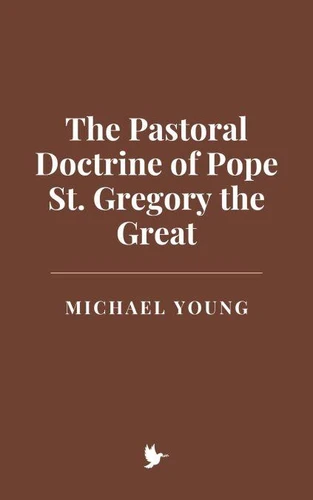The Pastoral Doctrine of Pope St. Gregory the Great
Par :Formats :
Disponible dans votre compte client Decitre ou Furet du Nord dès validation de votre commande. Le format ePub est :
- Compatible avec une lecture sur My Vivlio (smartphone, tablette, ordinateur)
- Compatible avec une lecture sur liseuses Vivlio
- Pour les liseuses autres que Vivlio, vous devez utiliser le logiciel Adobe Digital Edition. Non compatible avec la lecture sur les liseuses Kindle, Remarkable et Sony
 , qui est-ce ?
, qui est-ce ?Notre partenaire de plateforme de lecture numérique où vous retrouverez l'ensemble de vos ebooks gratuitement
Pour en savoir plus sur nos ebooks, consultez notre aide en ligne ici
- FormatePub
- ISBN8230426868
- EAN9798230426868
- Date de parution16/01/2025
- Protection num.pas de protection
- Infos supplémentairesepub
- ÉditeurIndependently Published
Résumé
The figure of Pope St. Gregory the Great stands as a monumental presence in the history of the Christian Church, not only for his ecclesiastical governance but for his theological depth and pastoral wisdom. Born around 540 AD in a Rome ravaged by political instability, famine, and plague, Gregory's formative years were shaped by the remnants of a declining Western Roman Empire and the rising influence of the Christian Church as a stabilizing force in a fragmented world.
This context is critical in understanding his vision of pastoral care as a response to the deep existential and spiritual crises of his age. The primary historical sources that recount Gregory's life and contributions include his own writings-most notably the Dialogues and the Regula Pastoralis (commonly known as the Pastoral Rule)-and later biographies, such as the Liber Pontificalis and the works of the Venerable Bede.
Gregory's Pastoral Rule, written early in his pontificate, was both a manual for bishops and a profound treatise on the nature of Christian leadership. It quickly became one of the most influential texts in the medieval Church, shaping the spiritual formation of pastors for centuries. It is important to note that Gregory was writing not as an abstract theologian but as a pastor deeply concerned with the practicalities of guiding souls amid the tumult of a fallen world.
This context is critical in understanding his vision of pastoral care as a response to the deep existential and spiritual crises of his age. The primary historical sources that recount Gregory's life and contributions include his own writings-most notably the Dialogues and the Regula Pastoralis (commonly known as the Pastoral Rule)-and later biographies, such as the Liber Pontificalis and the works of the Venerable Bede.
Gregory's Pastoral Rule, written early in his pontificate, was both a manual for bishops and a profound treatise on the nature of Christian leadership. It quickly became one of the most influential texts in the medieval Church, shaping the spiritual formation of pastors for centuries. It is important to note that Gregory was writing not as an abstract theologian but as a pastor deeply concerned with the practicalities of guiding souls amid the tumult of a fallen world.
The figure of Pope St. Gregory the Great stands as a monumental presence in the history of the Christian Church, not only for his ecclesiastical governance but for his theological depth and pastoral wisdom. Born around 540 AD in a Rome ravaged by political instability, famine, and plague, Gregory's formative years were shaped by the remnants of a declining Western Roman Empire and the rising influence of the Christian Church as a stabilizing force in a fragmented world.
This context is critical in understanding his vision of pastoral care as a response to the deep existential and spiritual crises of his age. The primary historical sources that recount Gregory's life and contributions include his own writings-most notably the Dialogues and the Regula Pastoralis (commonly known as the Pastoral Rule)-and later biographies, such as the Liber Pontificalis and the works of the Venerable Bede.
Gregory's Pastoral Rule, written early in his pontificate, was both a manual for bishops and a profound treatise on the nature of Christian leadership. It quickly became one of the most influential texts in the medieval Church, shaping the spiritual formation of pastors for centuries. It is important to note that Gregory was writing not as an abstract theologian but as a pastor deeply concerned with the practicalities of guiding souls amid the tumult of a fallen world.
This context is critical in understanding his vision of pastoral care as a response to the deep existential and spiritual crises of his age. The primary historical sources that recount Gregory's life and contributions include his own writings-most notably the Dialogues and the Regula Pastoralis (commonly known as the Pastoral Rule)-and later biographies, such as the Liber Pontificalis and the works of the Venerable Bede.
Gregory's Pastoral Rule, written early in his pontificate, was both a manual for bishops and a profound treatise on the nature of Christian leadership. It quickly became one of the most influential texts in the medieval Church, shaping the spiritual formation of pastors for centuries. It is important to note that Gregory was writing not as an abstract theologian but as a pastor deeply concerned with the practicalities of guiding souls amid the tumult of a fallen world.























